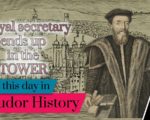
On 27th or 28th July 1553, Sir John Cheke was imprisoned in the Tower of London.
But how had a royal tutor and secretary ended up being thrown in the Tower?
Find out...

On 27th or 28th July 1553, Sir John Cheke was imprisoned in the Tower of London.
But how had a royal tutor and secretary ended up being thrown in the Tower?
Find out...

On 24th June 1604, in the reign of King James I, Elizabethan courtier and poet, Edward de Vere, 17th Earl of Oxford, died.
Find out about this rather colourful Tudor character in this edition of #TudorHistoryShorts…
[Read More...]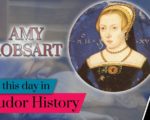
On 4th June 1550, Robert Dudley married his sweetheart, Amy Robsart, at the royal palace of Sheen at Richmond, near London, in a ceremony attended by King Edward VI.
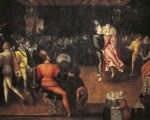
Today is International Dance Day, a global celebration of dance. The International Dance Day website explains “This day is a celebration day for those who can see the value and importance of the art form “dance”, and acts as a wake-up-call for governments, politicians and institutions which have not yet recognised its value to the people and to the individual and have not yet realised its potential for economic growth.”
To celebrate this day, we thought we’d share an article on 16th century dance. This article by Jane Moulder originally appeared in the February 2015 edition of Tudor Life Magazine.
[Read More...]
Today is World Book Day! It’s a day where we celebrate books and encourage everyone to read. For the UK and Ireland this is not the case, they are the only ones to celebrate it on a different day. For this occasion, we are treating you with an amazing interview with the lovely Adrienne Dillard. Her book ‘The Raven’s Widow’ will be coming out soon as an audio book!
The Raven’s Widow is a novel about Anne Boleyn’s sister-in-law, Jane Boleyn. Written by Adrienne Dillard, who works in the financial services by day, but spends all her free time on writing and researching the women of Henry VIII’s court. We talked to Adrienne about her book, Tudor fascination and why she believes Jane suffered from a mental illness.

This second part of this week’s “This week in Tudor History” covers events that took place in the Tudor period on 14th, 15th, 16th and 17th January. Find out all about these Tudor events
[Read More...]
Happy Christmas!
On this day in Tudor history, 25th December 1587, Brian Darcy, magistrate, Sheriff of Essex, witch-hunter and contributor to the 1582 “A true and just recorde of the information, examination and confession of all the witches, taken at S Oses [St Osyth]”, died.
“A True and Just Recorde” argued for harsher punishments for those found guilty of witchcraft, and Darcy was personally responsible for a number of deaths of people accused of witchcraft.
Find out more about this zealous witch-hunter in today’s talk.
[Read More...]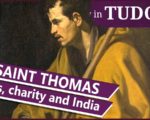
21st December in Tudor times was the Feast of St Thomas the Apostle, or Didymus or Doubting Thomas. The apostle who wouldn’t believe Christ had been resurrected until Christ appeared in front of him and he’d felt the nail wounds and the wound in his side.
Thomas was known for his generosity, and in Tudor times, those in need would go “a-Thomasing”, collecting alms. But there are also other traditions associated with the feast day, such as pie-making. And did you know that Thomas also has links to India?
Find out more about St Thomas, his story, his feast day and the traditions associated with him, in today’s talk.
[Read More...]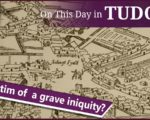
On this day in Tudor history, 20th December 1583, the day after his son-in-law, John Somerville, had been found dead in his cell, Warwickshire gentleman Edward Arden was hanged, drawn and quartered at Smithfield.
Arden, who was related to William Shakespeare’s mother, Mary Arden, and married to a member of the Throckmorton family, had been found guilty of treason, after being implicated in Somerville’s plot to kill the queen.
But was Arden actually guilty? Why didn’t others involved end up being executed too?
Find out more about Edward Arden and what happened in 1583, in today’s talk.
[Read More...]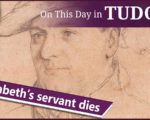
On this day in Tudor history, 15th December, 1560, Comptroller of the Household to Elizabeth I and Lord Lieutenant of Berkshire, Thomas Parry died. The Spanish ambassador claimed that Parry had died of “sheer grief”. He was buried at Westminster Abbey.
Parry had served Elizabeth since 1547 and was a loyal servant and friend. So why did he die of grief?
Find out more about Thomas Parry, his background, life, and why he was upset in 1560, in today’s talk.
[Read More...]
On this day in Tudor history, 12th December 1595, Protestant Welsh soldier and author, Sir Roger Williams, died from a fever with his patron, Robert Devereux, Earl of Essex, at his side. He was buried at St Paul’s Cathedral.
Williams served as a soldier in the Low Countries and France and was second in command of the cavalry under Essex at Tilbury Fort in 1588. He also wrote the 1590 “A Briefe Discourse of Warre”.
At one point he incurred Queen Elizabeth I’s wrath and had to go into hiding for a time.
Find out all about Sir Roger Williams’ life, career and works in today’s talk.
[Read More...]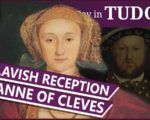
On this day in Tudor history, 11th December 1539, Anne of Cleves and her retinue were received at Gravelines, just a few miles outside of Calais, by Lord Lisle, Deputy of Calais.
Anne of Cleves was on her way to England to marry King Henry VIII, but her journey had been rather slow and she was about to be delayed even more.
The reception was rather lavish, with everyone dressed up to the nines. Enjoy a contemporary description from a Tudor chronicler in today’s talk.
[Read More...]
On this day in Tudor history, 28th November 1565, member of Parliament and political agent Francis Yaxley set sail for Scotland from Antwerp. Sadly, Yaxley’s ship was wrecked in a storm and he never reached Scotland, and neither did the gold he was carrying to Mary, Queen of Scots.
But why was he carrying gold and who was it from? What happened to the gold? Find out all about Yaxley, how he came to be travelling from Antwerp to Scotland, and what happened to him and the gold, in today’s talk.
[Read More...]
On this day in Tudor history, 24th November 1572, John Knox, the Scottish clergyman, famous Reformer , royal chaplain, and founder of Presbyterianism, died at his home in Edinburgh as his second wife, Margaret, read aloud from Paul’s First Letter to the Corinthians.
John Knox is known for bringing the Protestant reformation to the church in Scotland and his controversial views about women rulers, but he was also chaplain to King Edward VI and had a very eventful life, being taken prisoner by the French and being forced into service on the galleys of their fleet at one point.
Find out more about John Knox’s life and career in today’s talk.
[Read More...]
On this day in history, 20th November 1612, in the reign of King James I, courtier and author Sir John Harington died.
Why am I talking about a man who died in the Stuart period?
Well, because he was Queen Elizabeth I’s godson and because during her reign he invented the Ajax, or “jakes”, England’s first flush toilet.
Find out more about Sir John Harington and his flush toilet invention in today’s talk.
[Read More...]
On this day in Tudor history, 30th October 1600, Queen Elizabeth I refused to renew Robert Devereux, 2nd Earl of Essex’s monopoly on sweet wines, saying that “an unruly horse must be abated of his provender, that he may be the easier and better managed.”
It may not sound like a major event, but it was for Essex and it drove him to desperation and, ultimately, to the scaffold.
Why? What was going on? How could the queen’s refusal to renew this monopoly lead to Essex’s undoing?
Find out what was happened in 1600 and what happened next with the queen and her favourite, in today’s talk.
[Read More...]
On this day in Tudor history, 27th October 1561, Mary Herbert (née Sidney), Countess of Pembroke, writer and literary patron, was born at Tickenhall, near Bewdley in Worcestershire. She was the sister of the poets Sir Philip Sidney and Robert Sidney, Earl of Leicester, was a writer herself and an extremely talented lady, and she also lived life to the full.
After her husband died, she had fun shooting pistols, flirting, taking tobacco and dancing. A fun lady!
Find out more about this gifted Tudor woman, who was as beautiful as she was talented, and whose work was praised, and used, by men such as Shakespeare.
[Read More...]
On this day in Tudor history, 7th October 1529, Pope Clement VII wrote to King Henry VIII regarding his quest for an annulment of his marriage to Catherine of Aragon.
It wasn’t good news. Catherine of Aragon had won this battle, with the pope deciding that the marriage was valid, but she hadn’t won the war. Henry VIII did get the marriage annulled in the end, but the pope didn’t do it.
But what was going on? Why wouldn’t the pope help? What was Henry VIII’s argument for an annulment and on what grounds did Catherine appeal?
Find out more in today’s talk.
[Read More...]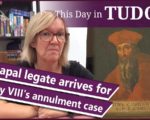
On this day in Tudor history, 29th September 1528, the papal legate, Cardinal Lorenzo Campeggio, landed at Dover on the Kent coast.
Campeggio and Cardinal Thomas Wolsey, who had been appointed the pope’s vice-regent, were given the task of hearing Henry VIII’s case for an annulment of his marriage to Catherine of Aragon.
Find out more about what happened when next, what happened at the special legatine court, and how Henry ended up waiting for his annulment for a few more years, in today’s talk.
[Read More...]
On this day in Tudor history, 21st September 1557, Henry Pendleton, theologian, chaplain and friend of Bishop Bonner, was buried at St Stephen’s, Walbrook, London.
Pendleton is known not only for his strong preaching, which led to him being shot at once, but also for his changing religious faith. He went from staunch Catholic to zealous Protestant to staunch Catholic, even taking part in disputations with his former friends and seeing them imprisoned and burnt.
Find out more about Henry Pendleton, his life, career and changing religious beliefs, in today’s talk.
[Read More...]
On this day in Tudor history, 8th September 1601, John Shakespeare, father of playwright William Shakespeare, was buried at Holy Trinity Church in Stratford-upon-Avon.
John was a glover and whittawer, and also an important man in the town of Stratford-upon-Avon, serving as high bailiff, chief alderman and deputy bailiff, and being given the right to educate his children at the local grammar school for free. However, he also ran into trouble at times.
Find out more about the life of William Shakespeare’s father, John Shakespeare, in today’s talk.
[Read More...]
On this day in Tudor history, 4th September 1539, William, Duke of Cleves, signed the marriage treaty promising his sister, Anne of Cleves, in marriage to King Henry VIII.
Anne would of course become Henry VIII’s fourth wife.
Find out all about the marriage agreement and its terms, and what happened next, in today’s talk.
[Read More...]
On his day in Tudor history, 15th August 1588, Catholics Robert Wilcox, Edward Campion, Christopher Buxton and Robert Widmerpool were examined while imprisoned in the Marshalsea prison in Southwark, London.
These men ended up being executed, three of them for being Catholic priests and one for giving aid to priests, at t. All four died with courage and in 1929 were beatified.
Find out more about these men and how they came to be executed in today’s talk.
[Read More...]
On this day in Tudor history, 14th August 1513, William Parr, Marquess of Northampton and brother of Queen Catherine Parr, was born.
William Parr is a fascinating man. He had a wonderful court career, his first wife eloped and left him, his divorce was granted and then rescinded, he was imprisoned in the Tower but then released, his marital happiness was rather shortlived… but he died a natural death!
Find out more about William Parr in today’s talk.
[Read More...]
On this day in Tudor history, 8th August 1553, fifteen-year-old King Edward VI was buried in Henry VII’s Lady Chapel in Westminster Abbey in a funeral service performed by Thomas Cranmer, Archbishop of Canterbury.
Although his Catholic half-sister, Mary, was on the throne, Edward was buried with Protestant rites and it was the first time the English Book of Common Prayer was used for the funeral of a monarch.
Find out more about Edward VI’s funeral, how Mary I marked his passing, and Edward VI’s resting place, in today’s talk.
[Read More...]
On this day in Tudor history, 7th August 1548, five-year-old Mary, Queen of Scots set sail from Dumbarton in Scotland bound for France.
A marriage had been agreed between Mary and Francis, the Dauphin, so Mary was going to be brought up at the French court. Mary travelled with her maids of honour, the Four Marys, or the Queen’s Maries: Mary Fleming, Mary Beaton, Mary Seton and Mary Livingston.
Find out more in today’s talk.
[Read More...]
On this day in Tudor history, 30th July 1553, Elizabeth, daughter of King Henry VIII and Anne Boleyn, left her new home, Somerset House, to ride to Wanstead and greet her half-sister, Mary, who’d been officially proclaimed queen on 19th July.
Somerset House was Elizabeth’s new London residence and you can find out more about how Elizabeth acquired it and who built it originally in today’s talk.
[Read More...]
On this day in Tudor history, 27th July 1593, Roman Catholic priest and martyr, Blessed William Davies, was hanged, drawn and quartered at Beaumaris Castle on the Island of Anglesey.
You may not have heard of William Davies, but he is believed to have been involved in the printing of “Y Drych Christianogawl”, or The Christian Mirror, an important early Welsh Catholic book and the first book to be printed on Welsh soil, while he was hiding in cave!
Find out more about Davies, how he came to be hiding in a cave in North Wales, and why he was executed, in today’s talk.
[Read More...]